Picture this.
You’re sitting across from your CTO. The company is betting big on spatial computing. You both know Apple Vision Pro isn’t just another shiny headset; it’s a paradigm shift; one that’s already reshaping how businesses think about product, engagement, and innovation. Apple Vision Pro Trends can back that up.
And yet, you’re stuck. Why? Because you don’t know how to hire visionOS developers who can turn that vision into real software.
If that sounds familiar, keep reading.
This isn’t a fluffy, surface-level piece. This is your visionOS developer hiring guide, built to help IT leaders like you understand what to look for in a visionOS developer, what skills matter, how much it costs, and what kind of tech stack you’ll need to support them.
Let’s get straight to the point.
Why Hiring a VisionOS Developer Is Not Like Hiring an iOS Developer
Think hiring a visionOS developer is as simple as repurposing your iOS team? Think again.
You’re not just building another mobile app. You’re stepping into an entirely new medium. Spatial computing. And if you’re serious about capturing early market share in the Apple Vision Pro Apps ecosystem, this decision isn’t just tactical.
It’s strategic.
Let’s unpack why hiring for visionOS is a whole different game and why getting it right can directly impact your ROI, your brand differentiation, and your long-term digital roadmap.
1. VisionOS Users Convert More and Pay More
Here’s something your finance team will love, native visionOS apps are monetizing faster than iOS apps ever did.
While the iOS App Store leans heavily on freemium and ad-supported models, nearly 50% of visionOS apps are paid upfront. Why? Because Vision Pro users are not your average mobile users.
They’re:
- Early adopters
- Willing to pay for novel experiences
- Actively searching for immersive, premium content
Translation: If you’re launching a visionOS app, you’re selling to an audience with higher intent and a bigger wallet.
That alone is reason to prioritize hiring developers who know how to design immersive, monetizable user experiences; not just functional features.
2. The Market Is Booming. The Talent Pool Isn’t.
The spatial computing market is projected to hit $280.5 billion by 2028, with a CAGR of 23.4%. visionOS is at the center of that boom.
But here’s the catch; the demand for visionOS developers is exploding, and the supply hasn’t caught up. Most iOS developers haven’t touched spatial frameworks like RealityKit or dabbled in immersive UX.
That’s why your approach to hiring matters. A strong visionOS developer hiring guide should help you filter for specialists who’ve already built for:
- 3D environments
- Gesture and eye-tracking inputs
- Immersive media experiences
- Cross-platform compatibility (iOS + visionOS)
And trust us, those developers are not sitting on job boards waiting. You need to know where to look, how to screen, and what to offer.
3. You’re Paying for a Specialized, Cross-Disciplinary Skill Set
Let’s talk technical complexity.
visionOS developer requirements go far beyond app logic and UI layouts. These developers blend mobile engineering with real-time 3D rendering, spatial design, and system-level performance optimization.
Here’s what they’re expected to know:
| Skill Area | visionOS Developers |
| Programming | Swift, SwiftUI, Combine |
| 3D & Spatial | RealityKit, ARKit, SceneKit |
| UX/UI | Spatial UX, eye and hand gesture design |
| Media | Immersive audio, USDZ asset integration |
| AI Integration | Core ML for personalized or intelligent experiences |
And that complexity affects the project scope and cost.
The cost to hire visionOS developers for a high-end app? Anywhere from $100K to $300K, with timelines ranging from 6 to 9+ months depending on features and fidelity.
Compared to standard iOS apps, which may cost $40K–$70K and take 3–4 months, the leap is significant, but so is the impact, especially when you compare apple vision pro vs meta quest 3 in terms of ecosystem maturity, developer tools, and user expectations.
4. Better Hires = Higher Success Rates + Lower Overhead
Companies that invest early in dedicated visionOS teams are already seeing results:
- 97% success rate for well-scoped spatial projects
- Shorter onboarding and training cycles
- More predictable delivery across agile sprints
Why? Because experienced visionOS developers bring multi-stack fluency. They’ve worked across AR/VR, mobile, and in many cases, AI-enhanced experiences.
This means:
- You don’t need to staff multiple siloed roles
- They can self-manage across design/dev/testing
- They scale easily: hourly, monthly, or on a product roadmap
So while the visionOS developer hourly rate may range from $100 to $200+, what you’re really paying for is speed, flexibility, and minimal friction.
5. VisionOS Development Isn’t Just Tech. It’s Brand Positioning.
Let’s zoom out for a second.
When you build for Vision Pro, you’re doing more than shipping an app, you’re signaling innovation. You’re showing your customers, investors, and competitors that your business is thinking ahead, not playing catch-up.
Smart companies are already leveraging VisionOS to:
- Launch spatial data dashboards with live AR overlays
- Offer remote product demos in 3D
- Use Core ML to deliver personalized, vision-driven training
- Enable inclusive design for users with visual or motor limitations
This is where hiring the right developer makes or breaks the outcome. You need someone who can integrate AI, accessibility, and spatial design with purpose. Not as afterthoughts.
What Makes a Great VisionOS Developer?
Hiring for innovation isn’t just about resumes. It’s about finding developers who can build immersive experiences that perform, convert, and scale. When it comes to spatial computing, the bar is even higher.
If you’re exploring how to hire visionOS developers, you’re not just looking for someone who can write Swift code. You’re looking for someone who can design for an entirely new dimension of interaction; one where the user doesn’t tap, but gestures, gazes, and moves through space.
It’s not enough to know how to build apps. Great visionOS developers know how to build experiences that feel real, respond intuitively, and deliver business results. These are engineers who think spatially, optimize obsessively, and execute with clarity because in this medium, every frame dropped, every lag in gesture response, breaks the illusion and kills engagement.
That’s why the real challenge isn’t finding “a developer,” it’s identifying the right one. Someone who combines technical depth, product intuition, and a user-centered mindset.
This section is your visionOS developer hiring guide built to help you understand what to look for in a visionOS developer, what separates good from great, and what kind of talent is worth the investment.
Because let’s be honest, the cost to hire visionOS developers is significant. So is the risk of hiring the wrong one. And if you’re wondering, “how much does a visionOS developer charge,” you’ll want to make sure every buck goes toward skill sets that move the product forward.
Ready to separate contenders from pretenders?
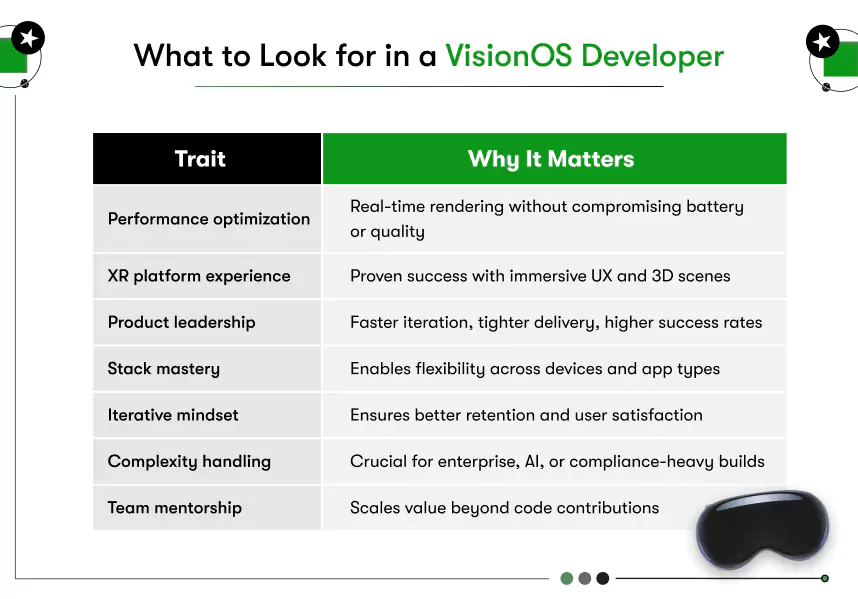
Let’s break it down:
1. They Master Performance, Where It Matters Most
Top-tier visionOS developer technical skills go far beyond writing Swift code. These developers understand spatial performance at the hardware level.
Case in point- Dynamically Foveated Rendering, a technique where the app intelligently sharpens only what the user’s eyes are focused on, reducing processing loads elsewhere. It’s how skilled developers deliver rich, immersive visuals without draining battery life or degrading performance.
You won’t find that level of precision in your average mobile engineer.
2. They Bring XR Experience from Other Platforms
The best visionOS developers often aren’t new to immersive tech; they’re veterans. Many have delivered award-winning AR/VR projects on platforms like Oculus Quest, Magic Leap, and HoloLens before moving into Apple’s spatial ecosystem.
One example? A visionOS developer who previously led a real-time architectural visualization app on HoloLens is now helping real estate firms build full-scale, walkable property demos on Vision Pro.
These cross-platform veterans are gold. Their adaptability, problem-solving speed, and vision-driven thinking often lead to higher quality, faster delivery, and better user retention.
Hiring Insight: When reviewing resumes, look for XR history. It’s often the strongest indicator of readiness for spatial development at scale.
3. They Lead Projects, Not Just Code Them
Great developers don’t just sit behind the keyboard. They lead agile teams, manage roadmaps, and take ownership of outcomes.
According to resume data, top visionOS engineers frequently operate like mini product managers. They:
Coordinate with designers and QA
Interpret business goals into technical milestones
Adjust priorities based on user testing and stakeholder feedback
These are the developers who don’t just ship apps; they deliver working products that evolve fast and grow even faster.
4. Their Stack Is Deep and Wide
A great visionOS developer is fluent in:
- Swift & SwiftUI: The foundation for building visionOS-native apps
- RealityKit & ARKit: For spatial scenes, gestures, and 3D content
- Unity3D: Often used for performance-heavy or cross-platform projects
- 3D asset tools like Blender or Maya (or at least how to integrate from them)
This multi-tool fluency allows them to adapt based on app needs, whether it’s real-time simulation or UI-focused dashboards.
Red Flag: If someone only knows Swift but struggles with ARKit or spatial UX, they’re not visionOS-ready, yet.
5. They Work Iteratively, Not Just Linearly
Spatial apps aren’t built in a straight line. They evolve with user interaction.
The best developers start small with MVPs and use real-world user testing to refine the product. This tight loop of iteration + feedback leads to smoother UX, fewer bugs, and higher adoption.
In fact, iterative releases in immersive development have been shown to boost user satisfaction by over 30% compared to one-time launches.
If you’re using a visionOS developer hiring guide, prioritize candidates who talk about testing cycles, telemetry data, and post-launch updates, not just “finishing sprints.”
6. They Handle Complexity Without Flinching
Let’s talk real numbers.
visionOS apps often cost between $10,000 and $100,000+, depending on feature complexity. Higher-end projects may require 3D modeling, AI integration, HIPAA or enterprise compliance, and multi-device syncing. This is especially true when companies choose to convert an app to visionOS instead of starting from scratch; bringing legacy complexity into a spatial-first environment.
So, if you’re asking how much a visionOS developer charges, the answer depends entirely on their comfort with complexity and innovation.
Tip: Ask how they’ve handled complexity before. If they’ve built end-to-end platforms, especially for XR; chances are they’ll thrive on your roadmap.
7. They Build Teams, Not Just Apps
Technical brilliance is great, but it scales only when it’s shared.
Elite visionOS developers often mentor juniors, document best practices, run internal workshops, and contribute to AR/VR communities. That translates into:
- Faster onboarding for your team
- Better code maintainability
- A stronger, more innovative culture
This type of developer becomes a force multiplier, not just a hired gun.
Real-World VisionOS Use Cases: How Industries Are Adopting Spatial Computing
When evaluating how to hire visionOS developers, you’re not just choosing technical skills; you’re investing in industry relevance. The best developers understand both immersive technology and the context in which it drives real business outcomes.
The truth is, visionOS is already reshaping core industries through spatial computing, enhanced AR/VR integration, and real-time 3D UX. It’s not theoretical. It’s happening fast.
According to Apple’s announcement at WWDC 2024, there are already 1.5 million+ visionOS apps in the ecosystem, just a short time after launch. Developers across healthcare, retail, real estate, and education are building spatial products that don’t just entertain; they train, convert, and sell.
And the opportunity is scaling rapidly. The global AR/VR market, heavily intertwined with visionOS development, is projected to grow from $25.1 billion in 2023 to $71.2 billion by 2028 at a 23.2% CAGR.
Let’s break down how this growth is translating into specific, measurable outcomes across industries and why it should influence your hiring strategy:
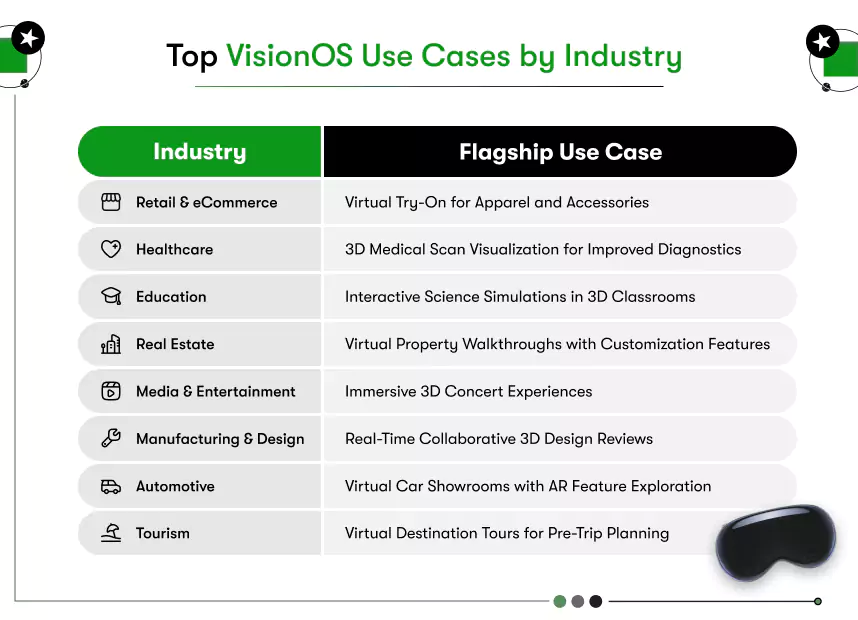
Retail & eCommerce
Use cases:
- Virtual try-ons
- 3D product visualization
- Fully immersive shopping environments
Results:
Retailers leveraging visionOS have reported higher engagement rates and fewer product returns. Customers are making more confident purchases thanks to spatial experiences like J.Crew’s “Virtual Closet,” where users try on and personalize outfits in real time before placing an order.
If you’re planning to enter this space, a key part of your visionOS developer requirements will include experience with interactive 3D assets, product configuration tools, and UX-optimized spatial environments.
Healthcare
Use cases:
- Surgical simulations
- 3D patient scan visualization
- Remote specialist consultations
Results:
Hospitals and edtech healthcare startups using visionOS apps have cut training costs and increased diagnostic accuracy. Developers have built tools that let clinicians explore 3D scans with gesture control, leading to better treatment planning and deeper patient understanding.
If you’re hiring for this vertical, the cost to hire visionOS developers may be higher due to regulatory and clinical demands, but the ROI in patient outcomes and training efficiency justifies the spend.
Tip: Look for developers with ARKit experience and a background in HIPAA-compliant or healthtech environments.
Education
Use cases:
- Scientific simulations
- Anatomy walkthroughs
- Historical recreations in 3D space
Results:
Immersive learning apps have significantly improved student retention, participation, and test performance. visionOS allows for complex topics like atomic structures or cardiovascular systems to be visualized and interacted with in 3D.
In your visionOS developer hiring guide, prioritize candidates with a passion for user engagement and experience in iterative UX testing, as educational apps often rely on continuous feedback and adaptation.
Real Estate
Use cases:
- Virtual home walkthroughs
- Architectural visualization
- Buyer-driven customization in spatial environments
Results:
Agencies using visionOS apps have reported faster deal closures and higher lead conversion rates. Prospects can walk through properties, finished or under construction; customizing layouts, lighting, and finishes in real time.
Here, what to look for in a visionOS developer includes experience in 3D scene optimization, USDZ asset integration, and gesture-controlled interactions.
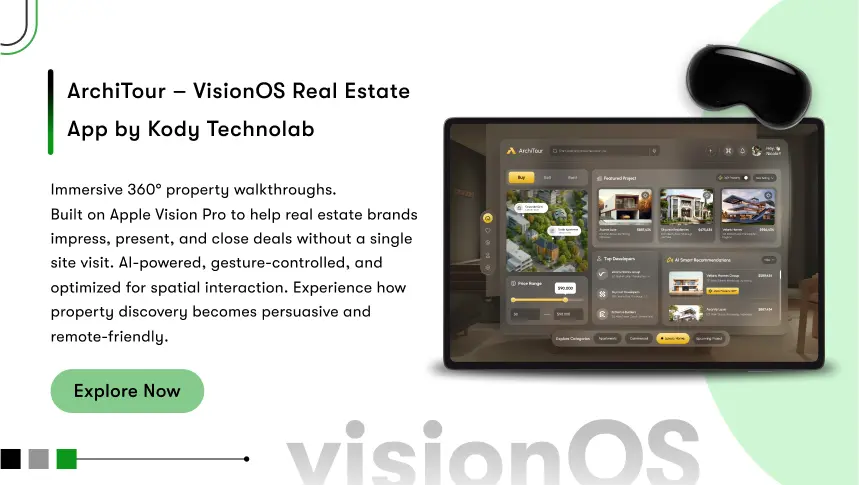
Media & Entertainment
Use cases:
- 3D interactive concerts
- Virtual movie screenings
- Immersive storytelling experiences
Results:
Platforms are seeing longer user sessions and more re-engagement with content built specifically for Vision Pro. Spatial concerts and performances allow fans to “step into” the event, creating entirely new monetization models.
If you’re building in this space, how much does a visionOS developer charge depends on content complexity and real-time streaming requirements. Look for developers familiar with spatial audio, real-time rendering, and user attention flow.
Manufacturing & Design
Use cases:
- Real-time 3D design reviews
- Remote factory floor visualization
- AR data overlays for equipment
Results:
Manufacturers using visionOS tools report fewer prototyping errors and faster decision cycles. Collaborative design sessions are now virtual, real-time, and data-rich; leading to leaner workflows and reduced time-to-market.
Here, visionOS developer technical skills should include collaborative real-time systems, cloud sync, and multi-user AR interaction models.
Automotive
Use cases:
- Virtual showrooms
- AR-guided car tours
- In-car real-time instructions via spatial UI
Results:
Automakers and dealerships report better-trained sales staff and higher customer satisfaction. Virtual tours improve buyer confidence and help streamline the sales cycle before even stepping into a dealership.
A developer with automotive UI/UX or AR navigation experience can bring significant value here, especially if they understand sensor integration and vehicle platform APIs.
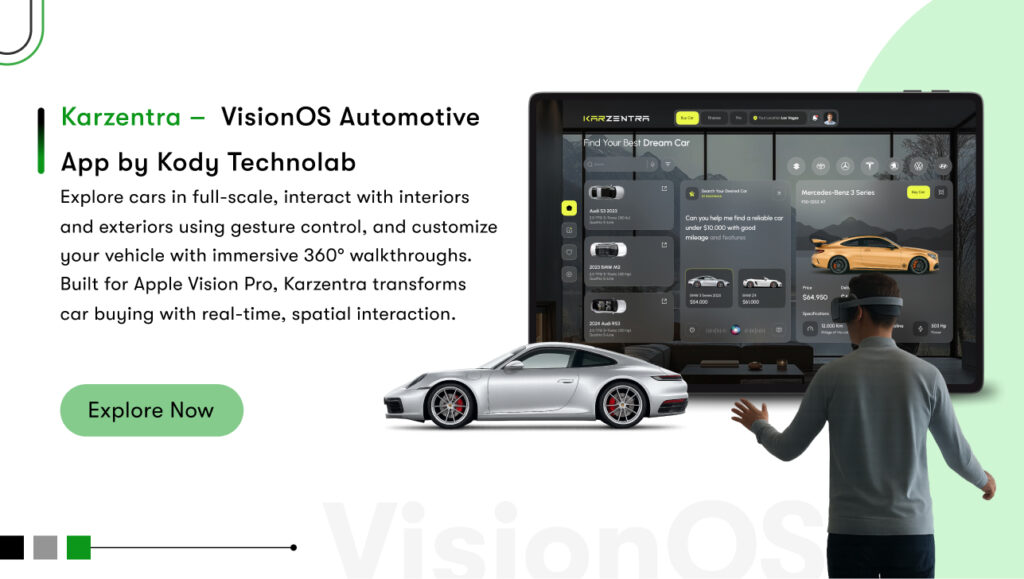
Tourism
Use cases:
- Virtual destination tours
- AR-enhanced historical guides
- Cultural immersion before travel
Results:
Travel platforms integrating visionOS have seen higher booking conversions and increased engagement time. Tourists feel more prepared and emotionally invested when they’ve “experienced” a destination before arrival.
This is where visionOS developer hourly rate can fluctuate depending on depth, basic AR scenes may cost less, but culturally rich, spatially accurate tours demand complex world-building skills.
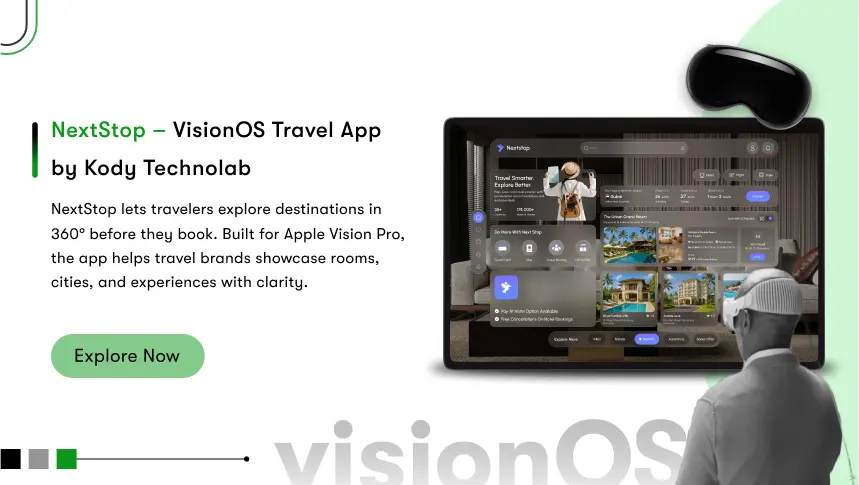
Why These Use Cases Matter When Hiring
You don’t just need a generalist. You need a developer who understands your industry and knows how to apply visionOS technology to solve specific business problems.
The takeaway?
The cost to hire visionOS developers is best justified when their skill set directly maps to your target outcomes; whether that’s reducing product returns, enhancing diagnostics, improving education, or unlocking new revenue in immersive content.
Every successful example in these Vision Pro Use Cases was built by teams that knew what to look for in a visionOS developer and made hiring decisions based not only on code but on industry insight, UX intuition, and spatial creativity.

What Are the Core VisionOS Developer Requirements?
You’ve seen the use cases. You know the opportunity is real. Now comes the hard part, hiring the developer who can actually deliver.
The best way to approach this? Treat it like building a product- define the requirements clearly, validate against them, and only then commit.
If you’re serious about how to hire visionOS developers, this section breaks down exactly what you should look for: technical skills, cross-functional experience, and problem-solving capability tailored to spatial computing.
Core Technical Stack: What Every visionOS Developer Must Know
The foundation of any strong candidate begins with mastery over Apple’s spatial development ecosystem. Here’s what to expect from a qualified developer:
| Skill Area | Tools & Technologies |
| Programming | Swift (required), SwiftUI (required), Combine (for reactive patterns) |
| Spatial & 3D | RealityKit, ARKit, SceneKit, Metal (optional but valuable for low-level rendering) |
| UX/UI | Spatial UX design, accessibility standards, hand/eye/voice interaction logic |
| 3D Assets | USDZ integration, asset optimization, basic knowledge of 3D modeling workflows |
| Testing & Debug | Xcode 15+, Reality Composer Pro, TestFlight, Scene debugging tools |
| AI Integration | Core ML (for personalized or contextual experiences) |
A candidate who checks most of these boxes is well-positioned to handle both the build and iteration phases of your product.
Product Thinking: More Than Just Code
What truly separates a great hire isn’t just their GitHub, it’s their ability to think like a product owner.
Exceptional visionOS developers can:
- Translate user flows into spatial experiences
- Identify edge cases unique to immersive UX
- Collaborate with designers, PMs, and QA in agile sprints
- Prioritize features based on device constraints (e.g. battery life, memory load)
So, if you’re asking yourself, “What to look for in a visionOS developer?”
Make sure cross-functional thinking is high on that list.
The Non-Negotiables: Use This Checklist
Here’s a concise evaluation framework to integrate into your VisionOS developer hiring guide:
| Requirement | Why It Matters |
| Swift + SwiftUI expertise | Core to visionOS development |
| RealityKit + ARKit proficiency | Enables immersive spatial interactions and rendering |
| Spatial UX & 3D experience | Critical for user comfort and functionality |
| Familiarity with Apple’s developer tools | Ensures faster setup and smoother workflows |
| Experience in MVP + iterative cycles | Vital for feedback-based product evolution |
| Soft skills: communication, collaboration | Enhances speed, reduces revisions, and aligns teams |
Pro Tip: In early interviews, ask about their first 30-day plan for building a basic MVP; you’ll immediately see how they think across tech and product lines.
Hiring for a bleeding-edge platform like visionOS carries risk, but the right hire will accelerate time-to-market, reduce long-term costs, and deliver a product that actually resonates with users.
Use this section not just to screen candidates, but to align your entire team from hiring managers to stakeholders, on what really matters when building spatial software. And if you’re planning a full-scale Vision Pro app development initiative, clarity around roles, skills, and expectations is non-negotiable.
How Much Does a VisionOS Developer Charge? Rates, Packages, and Project Costs Explained
When deciding how to hire visionOS developers, one of the first questions every product owner, founder, or CTO asks is simple but critical:
“What’s this going to cost me?”
The answer? It depends.
visionOS development sits at the intersection of high-end UX, AR/VR immersion, and Apple’s bleeding-edge spatial tech. That means rates aren’t just about hours, they’re about experience, technical depth, and project complexity.
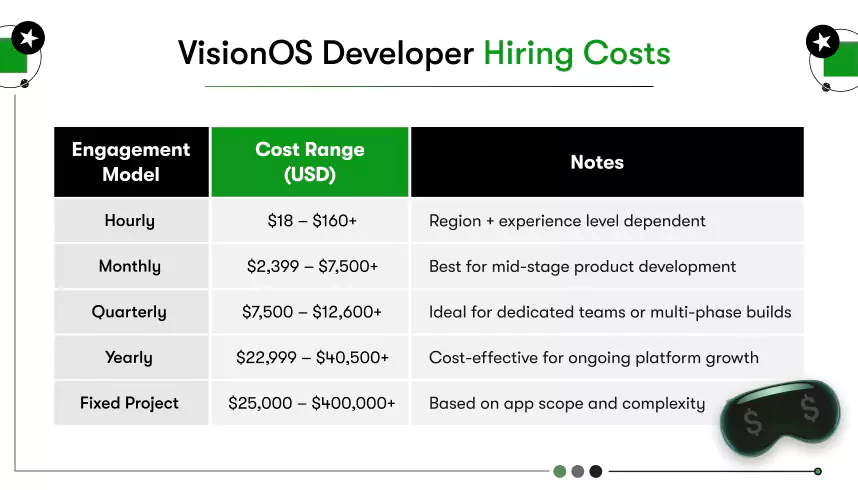
This section provides a complete breakdown of the cost to hire visionOS developers, including hourly rates, package deals, and full project pricing. Whether you’re budgeting for a prototype or planning a large-scale rollout, you’ll find real-world figures that help you forecast accurately.
Hourly Rates
If you’re working with contractors or freelancers, the visionOS developer hourly rate varies widely depending on region, experience, and demand.
| Role Level | Offshore Rate (USD/hr) | North America & Western Europe (USD/hr) |
| Junior Developer | $18 – $23 | $40 – $75 |
| Mid-Level Developer | $23 – $30 | $60 – $110 |
| Senior Developer | $30 – $40+ | $90 – $160+ |
Offshore teams like in India, and Eastern Europe often offer cost-effective talent with solid technical fundamentals, especially for MVPs and mid-range builds.
Monthly, Quarterly, and Yearly Packages
For companies with long-term projects, hiring through monthly or annual retainers is often more cost-efficient. These packages typically include dedicated team support, project management, and NDA protections.
| Engagement Model | Starting Cost (USD) | Typical Range (USD) |
| Monthly | $2,399 – $2,500 | $2,399 – $7,500+ |
| Quarterly | $7,500 – $7,599 | $7,500 – $12,600+ |
| Yearly | $22,999 – $25,000 | Up to $40,500+ |
These models work well for iterative product builds, ongoing support, or when internal teams need to scale without taking on full-time hires.
Fixed Project Pricing: Cost to Build a VisionOS App
How much does a visionOS developer charge for a full project? That depends on the app’s complexity, the quality of the assets, and how customized your user experience needs to be.
| App Type | Estimated Cost (USD) | Typical Timeline |
| Simple Viewer / Utility | $25,000 – $60,000 | 3 – 6 months |
| Moderately Complex | $60,000 – $120,000 | 6 – 8 months |
| High-Fidelity / Enterprise | $120,000 – $400,000+ | 9+ months |
Use this structure as a baseline when budgeting with agencies or vetting proposals. And remember, not all high prices equal high value. Refer to your visionOS developer requirements to assess if the quote matches the scope.
What Affects VisionOS Developer Costs?
If you’re still determining what to look for in a visionOS developer, consider these cost drivers. Each one significantly shapes your visionOS App Development Cost and knowing them upfront helps you budget smarter and hire better:
- App Complexity: More features, more 3D, more cost
- UI/UX Design Depth: Custom spatial interfaces take time and testing
- Quality of 3D Assets: Building or sourcing USDZ models drives cost
- Performance Optimization: Real-time rendering and gesture tracking require precision
- Team Location: Rates can double or triple between Eastern Europe and Silicon Valley
- Developer Seniority: High-end architecture, optimization, and leadership add premium costs
Final Thoughts: Don’t Hire a Dev. Hire a Co-Creator.
Navigating how to hire visionOS developers isn’t just a talent problem, it’s a product strategy decision. You’re not just filling a role; you’re investing in a skill set that can turn your app from experimental to exceptional.
We’ve covered what to look for in a visionOS developer, the technical skills that matter, hourly and project-based rates, and how different industries are already leveraging spatial computing for real business outcomes.
The bottom line? The right developer will cost more, but they’ll build better, move faster, and help you future-proof your digital roadmap.
Why Hire Kody Technolab Ltd for VisionOS App Development?
If you’re serious about building for Apple Vision Pro, you need more than code, you need vision.
At Kody Technolab, we’re not just another dev shop. We’re a visionOS App Development Company with hands-on experience designing, developing, and deploying immersive apps that scale. Our team combines deep expertise in Swift, RealityKit, and 3D asset integration, along with a strong product mindset that puts your users first.
Here’s why companies choose us when it’s time to Hire visionOS App Developers:
- Proven track record delivering AR/VR and spatial projects across multiple industries
- Flexible engagement models (hourly, monthly, or fixed cost) tailored to your needs
- UI/UX designers who understand spatial interfaces, not just screens
- Transparent communication and full-stack ownership from prototype to App Store launch
Whether you’re building a prototype, launching your first spatial product, or scaling a multi-platform experience, Kody Technolab brings the technical depth and creative vision to make it real.
Already working on something exciting? We’ll help you refine it, scale it, and Submit visionOS Apps that meet Apple’s technical and UX standards.


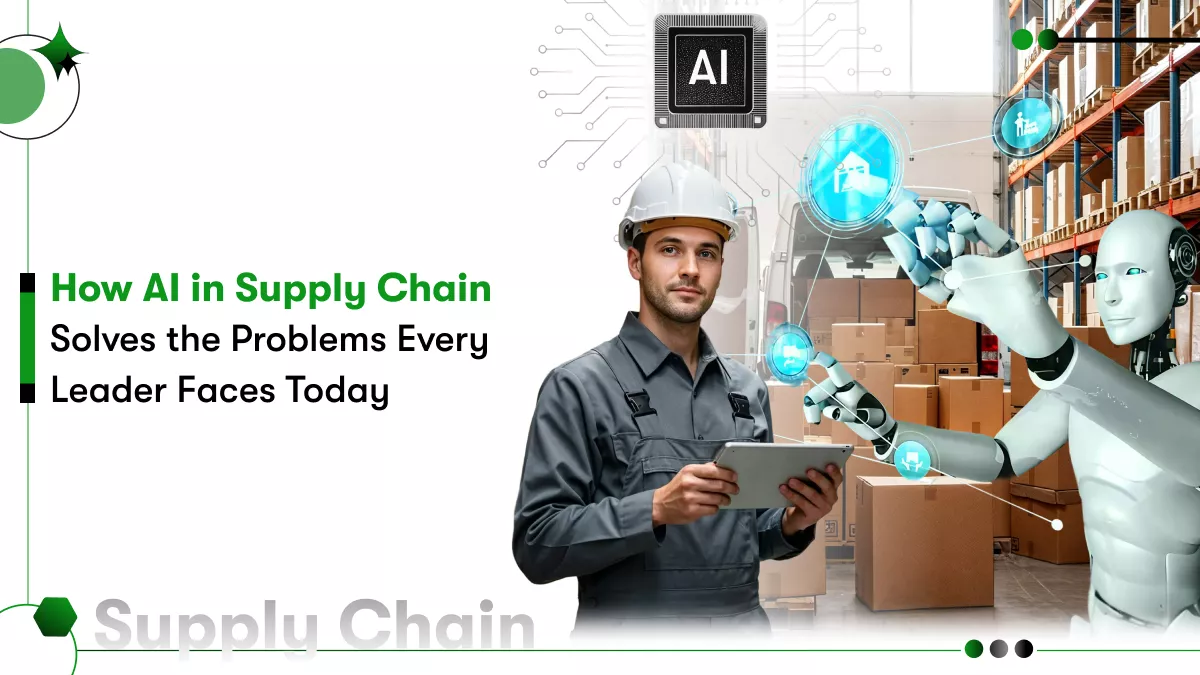

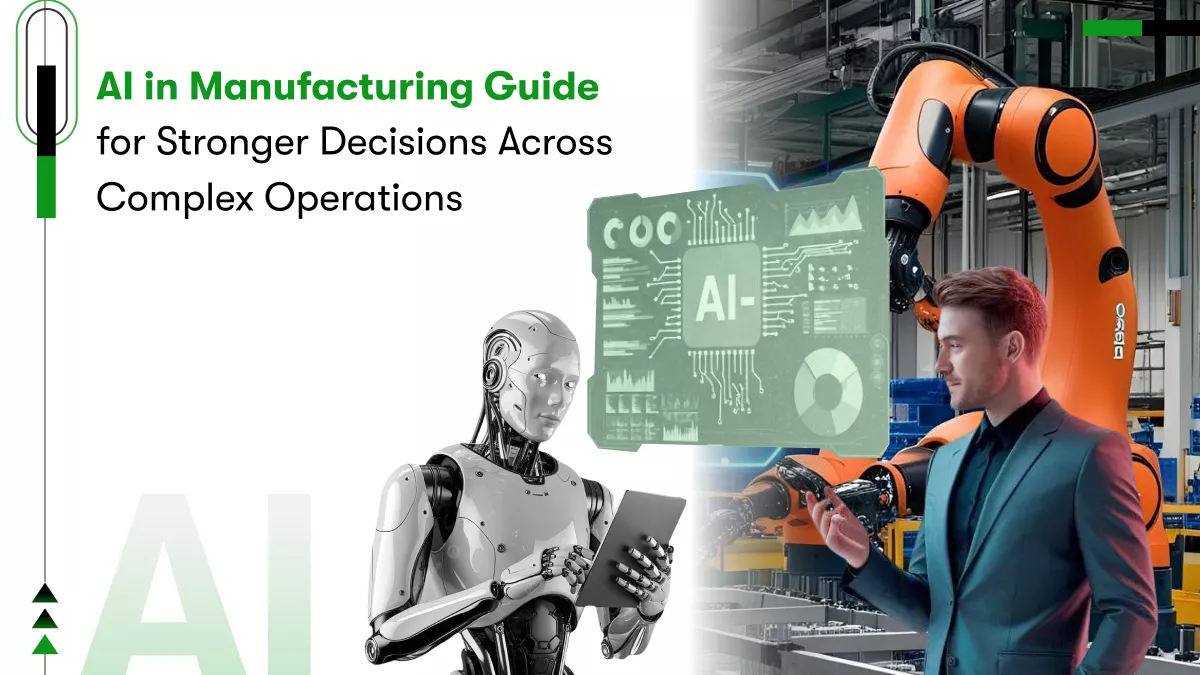
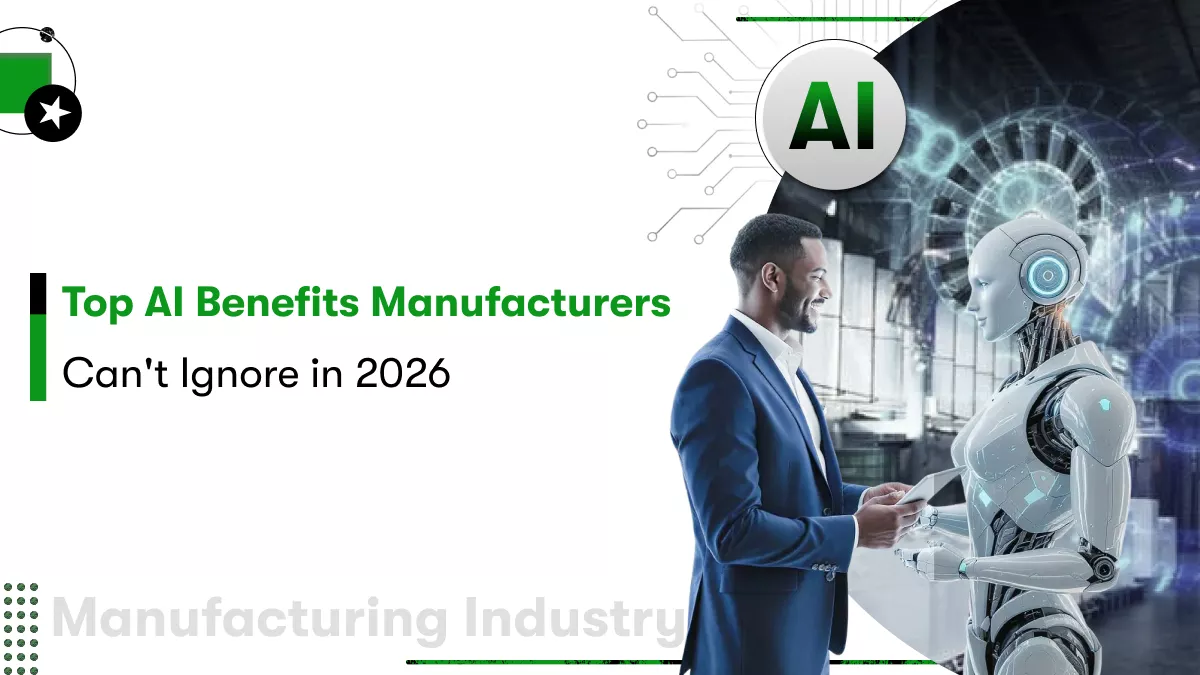
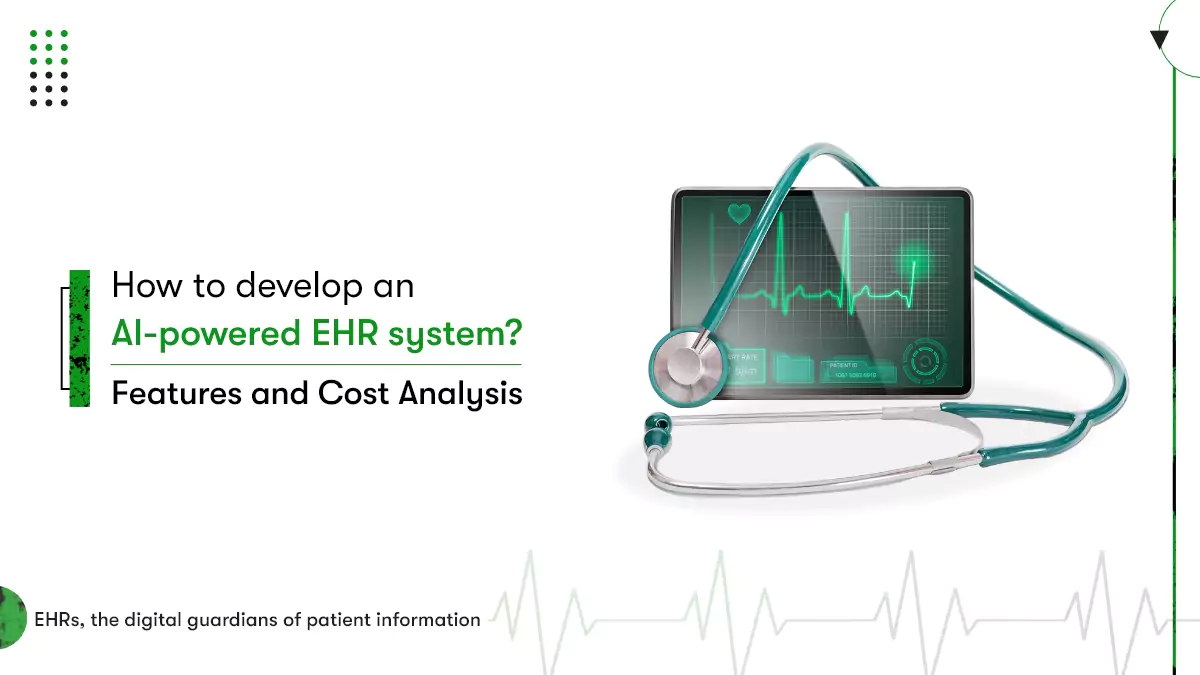






 Contact Information
Contact Information